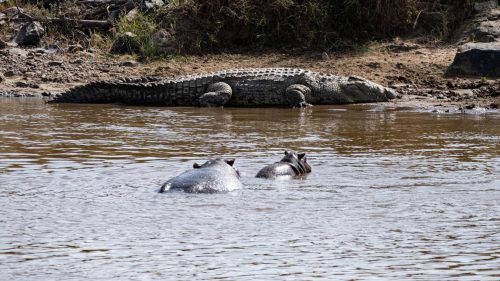Wilson, a member of Angama's guiding team, came into the Photographic Studio this week beaming with the widest smile I have seen from him. After watching the River Pride devouring the last of a baby topi, Wilson picked up his binoculars to scan for the next sighting with his guests; thanks to his sharp eyes and impeccable knowledge on animal behaviour, he noticed something peculiar with a single giraffe. A birth was taking place.
Witnessing animals giving birth in the wild is thrilling. It's also so rare that one should consider themselves extremely lucky — especially when the animal gives birth standing up in plain view. After 15 months in the mother’s womb, this little one was ready to come out. This long gestation period makes sure the calf is developed enough to quickly stand up and move around which is crucial with lots of hungry predators nearby.
With just the front legs showing, other giraffes approached the distressed mother giving birth. They were circled around her smelling the baby. Wilson explained that the birthing process looked painful as the mama giraffe moved around quite a lot; at one point she laid down and they exclaimed in fear, thinking she would crush the baby’s legs.
They watched as she would try and feed, probably to distract herself. For some reason she followed young baby giraffes nearby, smelling them intently. On a number of occasions, she would disappear into the riverine forest and at one point, just when her calf's head had popped out, she again disappeared into the forest again; they assumed she would drop the baby away from their view. They watched and waited with bated breath. Moments later, there was a sigh of relief when the giraffe emerged from the dense forest.
After a while, the other giraffes left her alone. It seemed like an eternity to give birth. Then finally it happened: a two-meter drop into the world. These newborn giraffes enter the world in a ‘superman’ position: front legs and head first, followed by their body, and then back legs. Because of the extreme size of their offspring, giraffe mums give birth standing up so as to not damage their babies’ lengthy necks.
To say patience is a virtue is an understatement as Wilson and his guests waited for nearly three hours from the moment the front legs showed until the baby finally touched the ground. Immediately after the baby was born, the other giraffes that were with her earlier came back to welcome the baby. Newborn giraffes are about six feet tall and weigh almost 70kg. That's some baby.
Interestingly, one single female giraffe stayed back with the new mom when the others eventually left, even helping the mother lick and clean the baby. She was probably closely related, perhaps a sister. After about five minutes, the newborn started kicking and pushing to get up. Just minutes after the calf was born, it stood up on wobbly, gangly legs, toppling over again and again.
The Mara has been awash with colour lately. The recent rains and the additional water is a welcome addition to the dry grasslands; the new green shoots are what Migration herds love to feed upon.
Though the river crossings are few and far between as of late, you can occasionally witness a small herd crossing the Mara River and even crocodiles making a kill. This is exactly what Alice, another member of our guiding team, and her guests saw at Main Crossing. A few wildebeests and zebras made the treacherous trek at arguably one of the most crocodile-infested points in the Mara River.
As expected, one wildebeest lost its life paving the way for others to cross safely. What looks a bit odd in the photograph is the lone zebra looking completely unperturbed by what is happening just a few feet away as a wildebeest is fighting for dear life. Somehow, I think they understand that once the crocs have their kill, they are less interested in the rest of the herd, so they feel safe.
Even for the fastest land animal, most hunts are unsuccessful. Cheetahs are often forced to abandon their chase which is not mainly due to overheating, as it is widely thought, but because they are outmatched. These visual hunters begin their hunt by detecting their prey and stalking them, followed by a chase that, if successful, ends with them tripping their prey and suffocating it with a bite to the throat.
With the cubs big enough to eat meat now, Risasi allows them to follow her during hunts. Here you can see as she leads them just before taking off after a baby Thomson's gazelle. This particular hunt was unsuccessful but it is interesting to see how the mother Thommy got in between her fawn and Risasi. Mother Thommys usually perform this sacrificial run to try and thwart the danger by drawing attention away from their fawn and then outrunning the attacker. It is also great to watch Risasi’s cubs seemingly cheer their mom on from the sidelines, learning all her tricks and skills. Hopefully, this will be their territory one day.

The Mara is home to some of the biggest Nile crocodiles in all of Africa and this time last year we couldn't stop staring at this monster of a croc who completely dwarfed the hippo in front of it.
Filed under: This Week at Angama
Subscribe for Weekly Stories
Comments (0):

Tented Suites